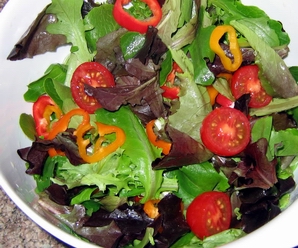 ding a few herbs and spices to vegetables and reduced-calorie meals makes these foods more appetizing to consumers, which may help Americans cut down on dietary fat and choose healthier food options, according to research presented at the 2013 IFT Food Expo.
ding a few herbs and spices to vegetables and reduced-calorie meals makes these foods more appetizing to consumers, which may help Americans cut down on dietary fat and choose healthier food options, according to research presented at the 2013 IFT Food Expo.John Peters, Ph.D., professor of medicine at the University of Colorado and chief of strategy and innovation at the school’s Anschutz Health and Wellness Center, presented data from an experiment he conducted using meatloaf, vegetables and creamy pasta. The test group of 150 subjects tasted the meal with full fat (610 calories), reduced fat, and reduced fat with everyday spices, such as onion, oregano, paprika and garlic (both 395 calories). The meals were randomized, and participants rated them using a nine-point Likert scale.
Results show the full-fat meal and the reduced-fat meal with spices both scored the same (about a 7.0). The reduced-fat meal with no spices scored about a 6.25. Peters said adding herbs and spices improved the reduced-fat version enough that it was rated as highly as the full-fat version.
The reduced-fat meatloaf with spices scored slightly higher than the full-fat version (6.75 vs. 6.50), while the reduced-fat only version was rated just above 6.0. Reduced-fat vegetables with spices scored slightly above 7.0, while the full-fat version scored just under 7.0. The reduced-fat only vegetables scored a little below 6.5. However, the full-fat creamy pasta was still more favored, scoring slightly above 7.25 vs. a little above 6.5 for the spicy reduced-fat version, and slightly below 6.0 for the reduced-fat with no spice.
Peters said reducing the fat in components (such as milk and cheese in the pasta dish) may contribute to an overall less satisfying feel and taste. Still, he noted that adding spices made up some of the ratings deficit between the full-fat version and the non-spicy reduced-fat version.
"Substituting herbs and spices for fat may be a promising strategy for helping people meet the Dietary Guidelines, especially if it's simple stuff you can buy in the store that doesn’t require any exotic training," Peters said.
He also urged the food industry to continue studying the relationship between herbs and spices and dietary satisfaction, which may benefit the health of U.S. consumers. Previous research suggests consuming reduced-fat foods, such as low-fat dairy products, can also reduce the risk of elevated blood pressure.





